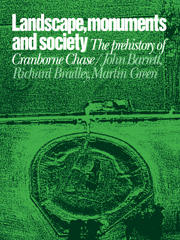Crossref Citations
This Book has been
cited by the following publications. This list is generated based on data provided by Crossref.
Bradley, Richard
1991.
Ritual, time and history.
World Archaeology,
Vol. 23,
Issue. 2,
p.
209.
Hammond, Norman
1992.
Book Reviews.
Journal of Field Archaeology,
Vol. 19,
Issue. 2,
p.
217.
Bradley, Richard
Cleal, R.
Cook, M.
Levitan, B.
Mead, B.
and
Harman, M.
1992.
The Excavation of an Oval Barrow beside the Abingdon Causewayed Enclosure, Oxfordshire.
Proceedings of the Prehistoric Society,
Vol. 58,
Issue. 1,
p.
127.
WHITTLE, ALASDAIR
1993.
THE NEOLITHIC of the AVEBURY AREA: SEQUENCE, ENVIRONMENT, SETTLEMENT and MONUMENTS.
Oxford Journal of Archaeology,
Vol. 12,
Issue. 1,
p.
29.
Hill, J. D.
1993.
Can we Recognise a Different European Past? A Contrastive Archaeology of Later Prehistoric Settlements in Southern England.
Journal of European Archaeology,
Vol. 1,
Issue. 1,
p.
57.
Whittle, A.
Rouse, A. J.
Evans, J. G.
Barker, C.
Cartwright, C.
Cruse, G.
Dennis, I.
Fairbairn, A. S.
Hamilton, M.
Macphail, R. I.
Noddle, B.
and
Pollard, J.
1993.
A Neolithic Downland Monument in its Environment: Excavations at the Easton Down Long Barrow, Bishops Cannings, North Wiltshire.
Proceedings of the Prehistoric Society,
Vol. 59,
Issue. ,
p.
197.
Vyner, B. E.
1994.
The territory of ritual: cross-ridge boundaries and the prehistoric landscape of the Cleveland Hills, northeast England.
Antiquity,
Vol. 68,
Issue. 258,
p.
27.
Ruíz-Gálvez, Marisa
1994.
The Bartered Bride. Goldwork, Inheritance, and Agriculture in the Late Prehistory of the Iberian Peninsula.
Journal of European Archaeology,
Vol. 2,
Issue. 1,
p.
50.
Needham, Stuart
and
Ambers, Janet
1994.
Redating Rams Hill and reconsidering Bronze Age enclosure.
Proceedings of the Prehistoric Society,
Vol. 60,
Issue. 1,
p.
225.
Barnatt, John
Beswick, Pauline
Chambers, Frank M.
Evans, John
Garton, Daryl
Mckinley, Jacqueline I.
Smith, Ken
and
Walster, Alison
1994.
Excavation of a Bronze Age Unenclosed Cemetery, Cairns, and Field Boundaries at Eaglestone Flat, Curbar, Derbyshire, 1984, 1989–1990.
Proceedings of the Prehistoric Society,
Vol. 60,
Issue. 1,
p.
287.
Woodward, Ann
1995.
Prehistoric land divisions on Salisbury Plain. The work of the Wessex Linear Ditches Project. By Richard Bradley, Roy Entwistle and Frances Raymond. 181 pp., 78 figs. London: English Heritage Archaeological Reports, 1994. ISBN 1850744777. £28.00..
Proceedings of the Prehistoric Society,
Vol. 61,
Issue. ,
p.
468.
SPENCER, NIGEL
1995.
HEROIC TIME: MONUMENTS AND THE PAST IN MESSENIA, SOUTHWEST GREECE.
Oxford Journal of Archaeology,
Vol. 14,
Issue. 3,
p.
277.
David, A.
Williams, G.
Jenkins, David
Rigby, Ian
and
Williams-Thorpe, Olwen
1995.
Stone Axe-head Manufacture: New Evidence from the Preseli Hills, West Wales.
Proceedings of the Prehistoric Society,
Vol. 61,
Issue. ,
p.
433.
Treherne, Paul
1995.
The Warrior's Beauty: The Masculine Body and Self-Identity in Bronze-Age Europe.
Journal of European Archaeology,
Vol. 3,
Issue. 1,
p.
105.
Harding, Jan
1995.
Social Histories and Regional Perspectives in the Neolithic of Lowland England.
Proceedings of the Prehistoric Society,
Vol. 61,
Issue. ,
p.
117.
Brück, Joanna
1995.
A place for the dead: the role of human remains in Late Bronze Age Britain.
Proceedings of the Prehistoric Society,
Vol. 61,
Issue. ,
p.
245.
Hill, J. D.
1995.
The Pre-Roman Iron Age in Britain and Ireland (ca. 800 B.C. to A.D. 100): An overview.
Journal of World Prehistory,
Vol. 9,
Issue. 1,
p.
47.
Allen, Michael J.
Morris, Michael
Clark, R.H.
Applin, Barbara
ApSimon, A.M.
King, Andrew C.
Newbury, M.
Russell, M.J.G.
Smith, Rachael Seager
and
Whitbread, I.K.
1995.
Food for the Living: a Reassessment of a Bronze Age Barrow at Buckskin, Basingstoke, Hampshire.
Proceedings of the Prehistoric Society,
Vol. 61,
Issue. ,
p.
157.
Ballard, Chris
1995.
The Force of Habit: Time, Being and Unconscious Acts in Archaeological Explanation.
The Australian Journal of Anthropology,
Vol. 6,
Issue. 1-2,
p.
203.
Pollard, Joshua
1995.
Inscribing Space: Formal Deposition at the Later Neolithic Monument of Woodhenge, Wiltshire.
Proceedings of the Prehistoric Society,
Vol. 61,
Issue. ,
p.
137.





